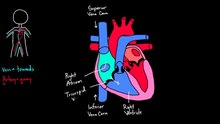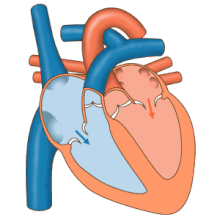Cardiac Physiology
Main article: Cardiac physiology
Blood flow
The heart functions as a pump in thecirculatory system to provide a continuouscirculation of blood throughout the body. This circulation consists of the systemic circulation to and from the body and thepulmonary circulation to and from the lungs. Blood in the pulmonary circulation exchanges carbon dioxide for oxygen in the lungs through the process of respiration. The systemic circulation then transports oxygen to the body and returns carbon dioxide and relatively deoxygenated blood to the heart for transfer to the lungs.[7]
The right heart collects deoxygenated blood from two large veins, the superior andinferior venae cavae. The blood collects in the right atrium and is pumped through the tricuspid valve into the right ventricle, where it is pumped into the pulmonary artery through the pulmonary valve. Here the blood enters the pulmonary circulation where carbon dioxide can be exchanged for oxygen in the lungs. This happens through the passive process of diffusion.
In the left heart, oxygenated blood is returned to the left atrium via the pulmonary veins. It is then pumped into the left ventricle through the mitral valve and into the aorta through the aortic valve for systemic circulation. The aorta is a large artery that branches into many smaller arteries, arterioles, and ultimately capillaries. In the capillaries, oxygen and nutrients from blood are supplied to body cells for metabolism, and exchanged for carbon dioxide and waste products.



0 comments:
Post a Comment